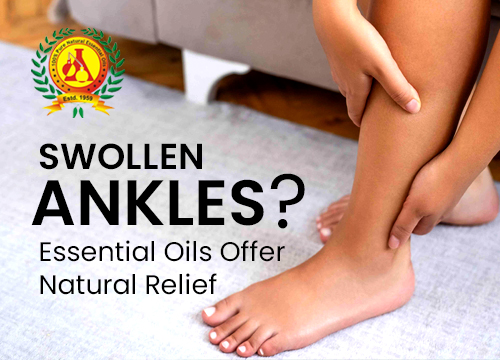Ankles swelling, medically known as edema, can be a frustrating and uncomfortable experience. It often manifests as puffiness, tightness, and discomfort in the ankle joint and surrounding tissues. While swelling is a common occurrence, it can be caused by various factors, ranging from minor injuries to more serious medical conditions.
Luckily, alongside conventional treatments, there are natural approaches to manage mild ankle swelling. Essential oils, concentrated plant extracts with potent therapeutic properties, offer a potential solution.This blog delves into the world of essential oils for ankle swelling, exploring the top contenders, their benefits, and safe application methods.
Understanding Ankle Swelling
Before diving into essential oils, let’s understand the potential causes of ankle swelling:
Injury: Sprains, strains, or fractures can cause inflammation and fluid buildup in the ankle, leading to swelling.
Chronic Conditions: Certain medical conditions like arthritis, heart disease, or kidney problems can contribute to ankle swelling.
Medications: Some medications, such as certain blood pressure medications or hormone replacement therapy, can cause fluid retention and swelling.
Pregnancy: Hormonal changes during pregnancy can lead to fluid retention and ankle swelling, especially in the later stages.
Prolonged Sitting or Standing: Sitting or standing for extended periods can restrict circulation and cause fluid to accumulate in the ankles.
Essential Oils: A Natural Approach to Relief
Essential oils offer a natural approach to managing discomfort associated with mild ankle swelling. However, it’s important to remember that they are not a cure-all and should be used in conjunction with addressing the underlying cause of swelling. Here are some of the top essential oils for ankle swelling and their potential benefits:
Lavender Oil: Renowned for its calming and anti-inflammatory properties, lavender oil can help reduce swelling and soothe discomfort.
Cypress Oil: This oil possesses diuretic properties, promoting healthy circulation and potentially reducing fluid buildup in the ankles.
Clary Sage Oil: Similar to cypress oil, clary sage oil may help reduce fluid retention by encouraging better circulation.
Peppermint Oil: The cooling sensation of peppermint oil comes from menthol, which can provide temporary relief from the discomfort and inflammation associated with ankle swelling.
Helichrysum Oil: This oil is known for its anti-inflammatory and analgesic properties, potentially reducing swelling and pain in the ankle.
Important Considerations Before Use
While essential oils offer a natural remedy, it’s crucial to remember these key points before using them for ankle swelling:
Dilution is Mandatory: Essential oils are highly concentrated and can irritate the skin if applied undiluted. Always dilute them with a carrier oil, such as jojoba oil, almond oil, or coconut oil, before topical application. A safe dilution ratio is typically 2-3 drops of essential oil per 1 teaspoon of carrier oil.
Patch Test First: Even diluted essential oils can cause allergic reactions in some individuals. Before applying the diluted oil to the affected area, conduct a patch test on a small area of your inner forearm. Apply a small amount of the diluted oil and wait 24 hours. If no redness or irritation occurs, it’s generally safe to use on the ankle.
Not for Sensitive Skin or Open Wounds: Essential oils are not recommended for use on very young children, pregnant or breastfeeding women, or individuals with highly sensitive skin or open wounds on the ankle.
Applying Essential Oils for Relief
Once you’ve diluted the essential oil of your choice and conducted a patch test, here’s how to apply it for ankle swelling relief:
Cleanse the area: Wash the swollen ankle with gentle, fragrance-free soap and pat it dry with a clean towel.
Prepare the compress: Soak a clean washcloth in cool or lukewarm water. Wring out the excess water.
Add the essential oil: Add 2-3 drops of your diluted essential oil blend to the damp washcloth.
Apply the compress: Gently place the cool compress on the swollen ankle for 15-20 minutes. Repeat this process 2-3 times a day for relief.
Additional Tips for Managing Ankle Swelling
Here are some additional tips to complement your essential oil treatment and promote faster healing of ankle swelling:
Elevation: Elevate your ankle above your heart whenever possible to help reduce fluid buildup.
Compression: Wear compression socks or stockings to improve circulation and reduce swelling.
Cold Therapy: Apply ice packs wrapped in a thin towel to the swollen area for short intervals (15-20 minutes) to reduce inflammation.
Exercise: Gentle exercises involving ankle movement can improve circulation and reduce swelling. However, consult your doctor before starting any new exercise program.
Conclusion
Essential oils can be a valuable addition to your ankle swelling management plan, offering a natural approach to reduce discomfort and inflammation. However, remember they are not a substitute for addressing the underlying cause of swelling. If your ankle swelling is severe, persistent, or accompanied by other symptoms like pain, redness, or fever, consult your doctor to rule out any underlying medical conditions and receive proper treatment. By combining essential oils with these additional tips and seeking professional guidance when needed, you can effectively manage ankle swelling and regain your mobility. If you are looking for the best essential oil manufacturer explore the range of Lala Essential Oils.


